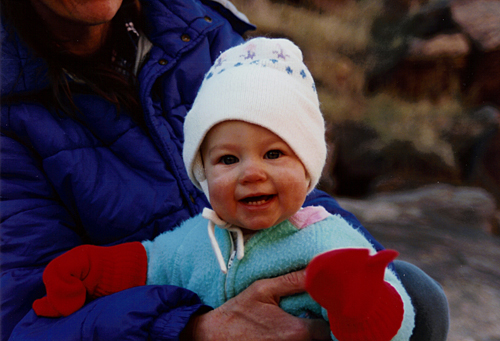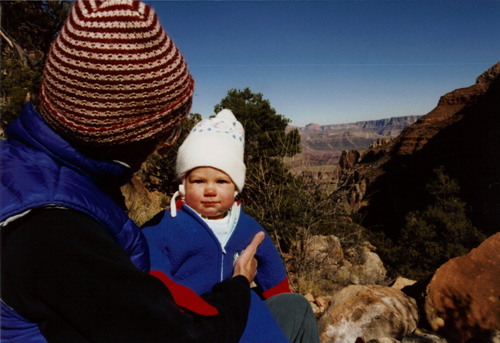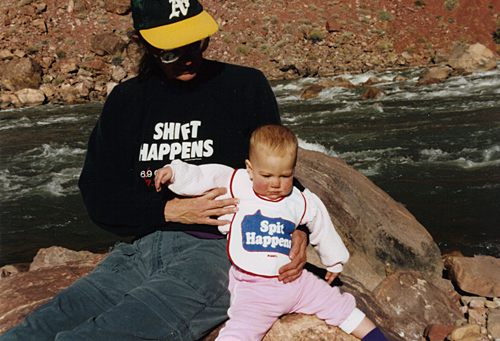When new parents bring home their first tiny bundle of joy from the hospital, they are so filled with the need to protect their infant from all possible dangers that the idea of taking a baby on a backpacking trip strikes many as ridiculous.
But it’s not. As I discovered 15 years ago, taking a baby along on wilderness excursions can be both safe and enjoyable. Parents will need to make major adjustments to their backpacking style and expectations — but that’s true of everything in life when a baby is born. And the result within a few years is a child who is comfortable in the outdoors, strong, and self-confident. Perhaps the most important outcome is a family that can engage in its favorite activity together.
Before all those good things can happen, Mom and Dad have to deal with some very practical issues. Every family is different and will have to work out the best approach, but here’s some of what I learned from experience.
Clothing:

In November 1994, we celebrated Mary’s first birthday by hiking down the New Hance Trail and staying four nights below the Grand Canyon’s rim. (Photo: Gary Chambers)
Dress the baby in layers, just as for any outing. We used footed blanket sleepers during chilly weather, one as a base layer and one of the next size up over that. Socks work fine for mittens. Knit caps are important in cold weather. During warm weather, use hats and sunscreen, and use a sunshade or rig one up with an old receiving blanket and diaper pins. Baby sunglasses will protect sensitive eyes. Infants can’t regulate their body temperatures well, so check often to make sure they aren’t too hot or too cold.
Feeding:
Breast is best, as the old saying goes, and it’s certainly easiest for backpackers. With breastfeeding, there are no containers to pack in or waste to pack out. Just make sure mom stays adequately hydrated to keep up her milk supply. I carried my daughter, Mary, in a sling for the first six months, and learned how to nurse her while walking.
Bringing along formula or solid foods for older babies adds some complications, but the extra weight won’t be a big problem if trips are kept short. Take a look at the foods you’re carrying in for the adults, and see what will work as baby food. Bringing along actual baby food may be unnecessary, as well as heavy.
Diapers:
We used disposable diapers; some parents use cloth diapers. Either way, whatever you pack in, you’ve got to pack out, preferably in a watertight plastic bag. Hand sanitizer gel and wipes will help with cleanup. Once, we met a couple who left their baby’s wet diaper out to dry overnight, only to discover the next morning that the fog had infused it with a lot more moisture than the baby had.
Kid Carriers:
Slings, wraps, and front-carriers like Snuglis and BabyBjorns are great for very young infants. Experiment with them on day hikes so you’re comfortable and can have your hands free when necessary. Parental preference and comfort will determine what type you use.
At about six months or so, when the baby can hold his head up, get a good-quality baby backpack. Like any pack, you, and anyone who’ll be carrying the baby, should try on carriers with weight before buying. We chose a Tough Traveler Stallion model with all the upgrades.
Infants will sleep a lot in their backpacks; you’ll discover during day hikes where your baby rests his head during naps. Then pad those spots to prevent chafing. We used pieces of flannel from an old nightgown. I learned to keep a little rearview mirror –the sort found in auto supply stores – in my pocket so I could check on what Mary was up to. Now, they’re often sold as carrier accessories, or you can borrow one from a bathroom kit.
Shelter:

Enjoying the view. (Photo: Gary Chambers)
A dome tent is ideal for families. Despite the added size and weight, a dome tent means having enough headroom to sit up during feedings and diaper changes, and while rocking the baby back to sleep. If the weather turns bad and you’re stuck inside for a few hours, the extra headroom — and the extra play room as baby becomes more mobile — will be much appreciated.
We had a dome tent with two doors. After dinner, I would put Mary to sleep on one side of the tent while Gary and I finished our camp chores. If she cried or was restless, I could open up the door on her side to reach her. When she was asleep and it was time for Gary and me to get in the tent, we could use the other door and avoid disturbing her.
Sleeping:
Babies move around a lot in their sleep; dress them appropriately for nighttime temperatures when they crawl around without waking up. Try fleece pajamas and sleepsacks. These are warm and safer than bedding, and in some climates may be sufficient for nighttime temps. By the time your baby turns one, you can experiment at home with child-size sleeping bags.
Avoid surrounding an infant with too much bedding, just as you wouldn’t put any loose bedding in a crib. Some parents feel comfortable sharing a sleeping bag with their baby, just as they share a bed at home. I didn’t want to risk rolling over Mary in my sleep, and we tried a number of arrangements before we found one that worked. We even tried toting along her car seat or a bouncer when she was very little.
What finally worked for us was dressing Mary in a footed blanket sleeper, so that she’d be warm even out of her thrift store, baby-size sleeping bag. The bag was meant for sleepovers, but was short enough that Mary couldn’t get down into it too far. We cut off the stuffed “animal head” pillow to save weight.

On the Colorado River below the rim of the Grand Canyon. (Photo: Gary Chambers)
Most of all, be prepared to do without much sleep during the first few months. I’d wake up every hour or so to find where Mary had gotten to in the tent and put her back in the bag.
Entertainment:
That rearview mirror also makes a good toy. Also, attach some soft playthings to the pack. Sing lots of songs and exercise your storytelling abilities. In camp, the tent makes a good playpen for a baby. As he grows, let him explore, as long as one parent is watching — all the time.
Crying:
Babies do cry. And that’s one more reason to go backpacking instead of car camping. When you’re miles away from everybody else, there’s no one to disturb.
Every family is different, and individual parents have to work out for themselves when and how to resume backpacking. Some start with very short trips and shuttle two or three times between car and campsite to deliver gear. Some hook up with families whose children are old enough to walk, so those parents can carry more of the gear for the group. The main thing is to stay well within your comfort zone so that you can devote most of your time and attention to making the trip a safe and happy one for that tiny child who will someday grow up to love the wilderness as much as you do.
Barbara Egbert has been backpacking, with and without a child, since 1988. In 2004, Barbara, husband Gary, and then 10-year-old daughter Mary hiked the 2,650-mile Pacific Crest Trail. Visit Barbara at www.PCTfamily.com.
This article is the first in a four-part series on backpacking with children of different ages.
Part 1: Backpacking with Baby
Part 2: Backpacking with a Toddler or Preschooler
Part 3: Backpacking with a Grade-Schooler
Part 4: Backpacking with a Teen

 by Barbara Egbert
by Barbara Egbert









